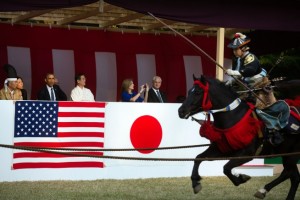US ‘pivot to Asia’ off to shaky voyage
- By admin
- 27 April, 2014
- No Comments
By Arthur Bariuad
US President Barack Obama wraps up his week-long diplomatic and trade expedition with a two-day visit to Manila starting Monday, the last leg of his four-nation trip to Asia that was meant to step up American engagement in a region increasingly dominated by an assertive China.
US officials have drummed up the importance of Mr. Obama’s Asian odyssey as a sign of Washington’s greater engagement in the region under the “pivot to Asia” strategy. But nothing concrete has so far emerged in whatever shape or form to shape that would give life to the policy initiative.
Mr. Obama commenced his four-nation tour of Japan, South Korea, Malaysia and the Philippines widely perceived as a weakened leader of the free world in the aftermath of his inability to rein in Russia’s annexation of Crimea last month and his indecisiveness over Russian President Vladimir Putin’s continued incursions into Ukraine.
On such an important trip to the Asia-Pacific region where China’s aggression is causing serious concerns, Mr. Obama showed no signs of reversing the perception.
Mr. Obama began his Asian odyssey on Wednesday hoping to open Japan to more American products, but he left Tokyo without ever securing an agreement with Japanese Prime Minister Shinzo Abe to finalize the ambitious Trans-Pacific Partnership trade pact over disagreements with beef imports, rice and other farm products.
The setback in Japan reflects the challenge Mr. Obama continues to deal with to translate his ideas into enduring policies. Still, Mr. Obama declared the US was obligated by a defense treaty to protect Japan in its confrontation with China over the Senkaku islands in the East China Sea, but side-stepped the issue of ownership in a calibrated effort to avoid antagonizing China, America’s second largest trading partner.
The US “pivot to Asia” strategy was unveiled almost three years ago to reorient US foreign policy with greater emphasis on diplomatic and economic efforts toward Asian and Pacific nations. But it never took off as Washington was hobbled by more pressing issues such as the Middle East uprisings, the Syrian civil war and fresh diplomatic initiatives with Iran as well as the ongoing crisis in the Ukraine.
In a speech before the Australia’s parliament in November 2011, Mr. Obama said the US “will allocate the resources necessary to maintain our strong military presence in this region” and “will preserve our unique ability to project power and deter threats to peace.”
Since then, the US acted more like pivoting away from Asia and elsewhere. Last January, the Pentagon drew up plans to cut the size of the US military to its lowest level since the Second World War, reflecting reduced defense budget, even as China steadily shored up its military capability.
Asian analysts believe China has made considerable headway modernizing its military and that the US may have waited too long and done too little to counterbalance Beijing’s regional aggression.
Nevertheless, Asian leaders are more than eager to roll out the red carpet for the US president in hopes his presence alone will calm fears of an adventurous China.
For years, Japan lobbied for the trip to materialize, which turned out to be the first state visit by an American president in almost two decades. Mr. Obama’s visit to Malaysia will be the first state visit by a US president in half a century.
That sentiment is more pronounced in Manila where Aquino administration officials had been touting renewed engagement with Washington following years of “benign neglect”, as a security blanket against China’s bullying over contested islets and atolls in the South China Sea, which are believed to contain rich deposits of oil and minerals.
Already, US and Philippine officials have finalized negotiations over an agreement allowing U.S. military to have extensive access to Philippine military bases. It would be the most substantial US military presence since the Philippine Senate rejected a basing agreement in September 1991 that forced the US to vacate Subic Bay Naval Base a year later.
Filipino officials trace the beginnings of China’s “creeping invasion” into the South China Sea at the time of the withdrawal of US troops in the Philippines more than two decades ago.
In February 1992, just as the Pentagon commenced the pulling out its forces in Subic, China passed a law declaring the entire South China Sea as its territory.
In 1994, China secretly started building structures on stilts on Mischief Reef, about 130 miles west of Palawan, triggering a protest from the Philippines. Beijing rejected the protest and claimed the structures were shelter for fishermen.
Over the years, China built more structures on the reef, including communications satellite, which Manila claimed resembled military installations than shelters for fishermen. FS

 Copyright © 2025
Copyright © 2025
Recent Comments